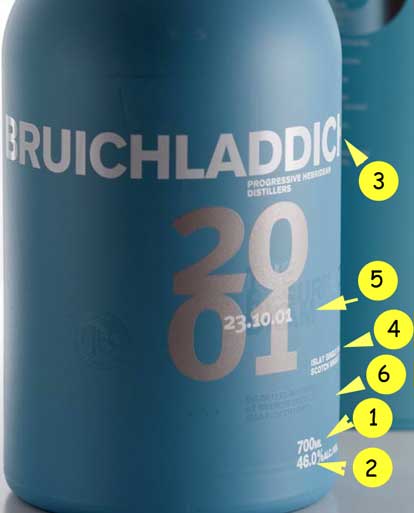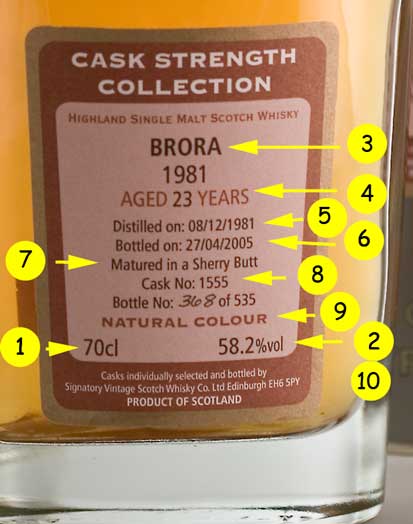

Labels
The label is the most important single element of identification of a whisky bottle. The label is generally made of paper or might be occasionally engraved on the bottle itself. The purpose is this item is to identify the product and the trade name or brand.
The amount of information present on the label might be very limited (e.g., only volume of the bottle, strength and a brand name) to very extensive (see for example label 3). In this document, I will try to explain the different information that you can gather just by reading a label, based on 3 different examples (label 1, 2, and 3).
So let’s start with the number 1:

Well, the label is directly printed on the bottle and some writing is printed on in such a way that you have to play with the light in order to guess some parts of the text:
Summary: This label is relatively succinct, providing only information about the distiller, the location of the maturation and its bottling, as well as the strength of the whisky. No information concerning the age of the whisky is provided. You have to go and search on the web (e.g., at www.bruichladdich.com) to find out that this Bruichladdich was indeed distilled in 2001 and that the malt used for this whisky is unusually peated at 10 ppm instead of 5 ppm as for most Bruichladdich bottlings. With a phenolic level of 10 ppm, the whisky is likely to be medium-lightly peated.
Label N°2:

3) Age: The age indicates the age of the youngest whisky present in the bottle. In this case, the youngest whisky is a least 12 years old.
4) Glen Lairg: this is a trade name and does not correspond to the name of a distillery. This whisky could have been produced by any distillery(ies) in Scotland.
5) Pure Highland Malt Scotch Whisky: this information is rather vague and “Pure” is unspecific. This might be the product of 1 or several distilleries (most of the time). Malt indicates that only malt whisky was used. Highland indicates the whisky has been produced anywhere in the Highlands (including Speyside). Since about 90% of the distilleries are located in this area, this does not help very much to identify the distillery(ies). In addition, different styles of whiskies are produced in this region, so the whisky can be anything from malty to peaty, with or without sherry influence.
6) Distilled, Matured & Bottled in Scotland by Clydesdale Scotch Whisky Co. Edinburgh. In this case, the only information provided is the name of the owner of the brand. In this case, a blender in Scotland based in Edinburgh. All the production steps, distillation, maturation and bottling could have taken place in 3 different locations in Scotland.
Summary: This is a typical label to be found on the shelves of a supermarket, with information made to confuse the consumer about its provenance. At the exception of the volume and strength, the only information valuable found on this label is that this whisky is at least 12 years old and that it is made exclusively of malt whisky. However, no information about the distillery(ies) is provided, nor the place of maturation and of bottling. Needless to say, you can only guess at the flavour profile of this whisky.
Label 3:

1) See label 1.
2) Strength: whiskies are traditionally bottled at 40, 43 or 46%. When the strength is different from these values, it might suggest that the whisky is cask strength, or directly bottled straight from the cask.
3) Brora: This is the name of the distillery
4) Age: Age of the whisky.
5) Distillation: This label is very precise, with the exact date of the distillation and cask filling.
6) Bottled: Exact date when the content of the cask was bottled.
7) Maturation in a sherry butt. This provided information on the type of cask used for the maturation of this whisky. Sherry: indicates that the oak cask used for the maturation has previously contained sherry. Butt indicates the size of the cask used for its maturation. See Cask for the respective volume of this type of cask.
8) Cask: Indicates the number of the cask in which the whisky was matured.
9) Natural Colour: Indicates that the colour of the whisky is natural. In most whiskies bottled at 40-43%, caramel is usually added to the whisky in order to obtain consistent colour between the different batches.
10) Cask individually selected and bottled by Signatory (…). No information is provided about the maturation, but this cask was selected by the company who bottled this whisky. This also indicates that the company which bottled the whisky is probably not the owner of the distillery.
Summary: this label provides almost all possible technical details about the whisky, the place of maturation being the only missing information.
I have selected 3 labels, rather different from each other to illustrate the variability of information that a label can carry. Some do only carry the strict minimum (volume, strength and brand name), while some are more exhaustive, even including tasting notes on top of the cask number, type of wood, etc. At the start, the label was used to promote the brand and to capture the attention of the customer by adding illustrations of Highlanders, Scotish Glens and other “archetypical” Scottish images, without any reference to the content (e.g, smooth or peaty whisky, old or young). For single malt whiskies, the situation was not much better, with Gordon & MacPhail being pioneering in indicating the age of distillation. Nowdays, the situation has considerably improved, with most (back) labels providing information about the flavour profile and the production process and/or other marketing information. Until the 1990s, more than 95% of the whisky produced in Scotland was blended whisky, and the lion’s share caring the following brand names: Johnny Walker, Teacher’s, Ballantines, J& B, Dewar’s, Haig, White Horse and a few others. Since the last 10 years or so, single malts and whisky in general, have become more fashionable and consumers more knowledgeable and curious. As a consequence, the information carried on the label has significantly improved. Age has always been an important element of information to attract the customer and the price tag associated to older whiskies. Recently, a few companies (e.g., Glenmorangie, Bruichladdich) have stepped back and decided to simply delete the age statement or to replace it with the vintage information. This allows the companies to keep the age of the content non-disclosed for mainly two reasons: to allow fluctuation in the age of the whisky due to stock availability and/or to justify a high price for a very young whisky. Of note, absence of age statement is not necessarily associated with low quality product.
As a conclusion, a label is the single most important identifier of a whisky bottle. Information on the label can be very limited or very exhaustive. Not only can it be used to identify a brand, but it can help to date the bottle (for whisky collectors), to help the choice of a consumer or to find more information about its contents (e.g., tasting notes). I hope that this report will help you to get the most of the label the next time that you are in a whisky shop!
Slainte.
P.Brossard ©Jul. 2009